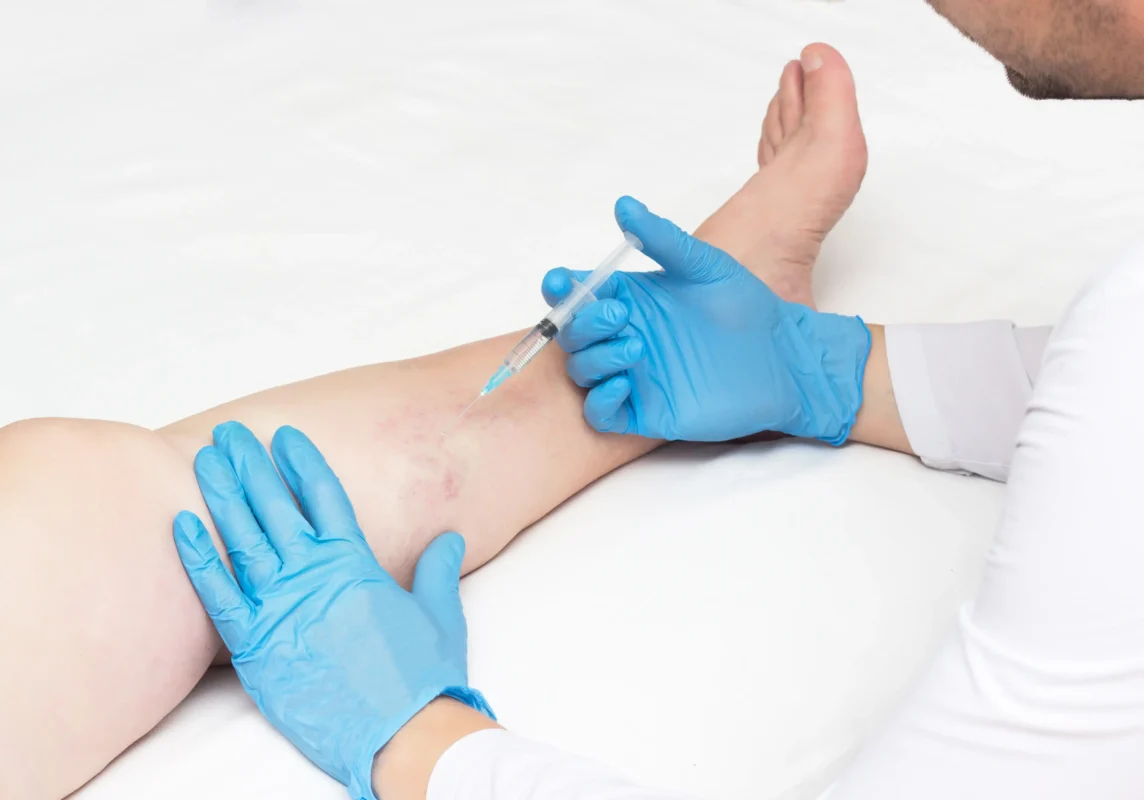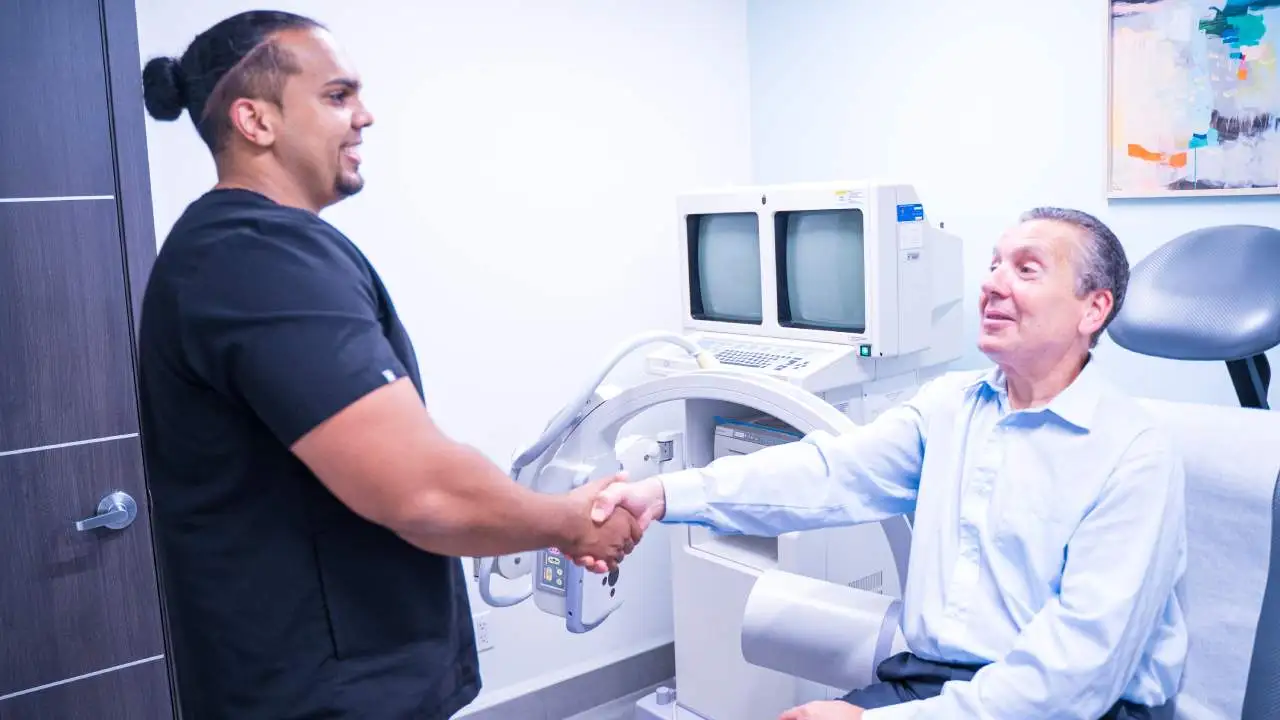What is Sclerotherapy?
Sclerotherapy is widely considered the best and most reliable spider vein treatment. Sclerotherapy has been around for decades, and it has undergone numerous changes to make it more effective and painless for patients. The general principles of sclerotherapy remain the same, even if the medications used for the procedure change over time. Sclerotherapy is a minimally invasive procedure that involves injecting unique sclerosant medications into unhealthy spider veins. The medication seals the spider veins’ walls shut, turning them into hardened scar tissues eventually reabsorbed by the body.

Sclerotherapy can be performed using numerous sclerosant solutions. In the past, sclerotherapy was performed using hypertonic saline, i.e., concentrated salt solution. Injecting hypertonic saline into spider veins certainly works — the spider veins collapse and get absorbed by the body. But hypertonic saline also causes considerable pain, burning sensations, and discomfort. Our state-of-the-art vein treatment clinics use the latest and safest sclerosant medications to produce optimal results without pain and discomfort. Please schedule an appointment for your sclerotherapy procedure at our vein treatment clinics today.

Benefits of Sclerotherapy:
- Minimally Invasive Procedure: Sclerotherapy is a minimally invasive procedure performed via injections. The vein doctor injects sclerosant into the unhealthy spider veins using ultrafine needles — the number of injections depends on your goals. There are no incisions, open surgeries, or hospitalization.
- Painless/ Comfortable Procedure: Sclerotherapy is a virtually painless procedure, especially when performed by board-certified vein doctors. If you visit reliable vein doctors, they will use advanced sclerosant solutions that don’t cause excess discomfort. You might feel a mild cramping sensation when the sclerosant enters your body, but it’s tolerable.
- Outpatient Procedure: Sclerotherapy is performed as an in-office, outpatient procedure. The procedure concludes within 30 minutes, following which you can resume your daily activities. There is no hospitalization. Most patients undergo sclerotherapy during their lunch break at work, following which they resume their work and daily activities.
- No Downtime/ Recovery Period: Sclerotherapy doesn’t involve any downtime. You may have to wear compression stockings for a few days, and you should avoid heavy lifting. But there are no major activity limitations. You can resume most of your daily activities and work immediately after the procedure.
- No Harsh Complications: Traditional varicose vein surgeries involve a fairly high risk of side effects and complications, such as infections anddeep vein thrombosis. But sclerotherapy carries a negligible risk of complications because it only involves a few simple injections.
- Decades of Evidence: Sclerotherapy has been used for spider vein removal for decades in different forms. Earlier sclerotherapy techniques were more painful than contemporary techniques. But sclerotherapy in all its forms has a nearly perfect success rate, backed by decades of clinical evidence and studies.
How Does Sclerotherapy Work?
Spider veins are damaged blood vessels that leak blood into the surrounding skin tissues. They appear in dense clusters on the skin’s surface, just underneath the epidermis. Sclerotherapy essentially works by sealing and destroying the walls of the spider veins, turning them into hardened scar tissues. The unhealthy spider veins initially darken on the skin’s surface, but they eventually fade away as your body reabsorbs and metabolizes the scar tissues.
Foam Therapy for Varicose Veins
Sclerotherapy only works on spider veins — not larger vein problems and varicose veins. That’s because the vein doctor can only use a small dose of sclerosant medicine safely. Exceeding the safety limits can have unwanted consequences. Until recently, vein doctors could only use the sclerotherapy technique for spider veins. But now, thanks to recent advancements, vein doctors can also treat varicose veins using the same, minimally invasive technique.
Foam therapy for varicose veins uses the same techniques as sclerotherapy. Instead of injecting liquid sclerosant into spider veins, the vein doctor injects a foamy solution of the sclerosant medicine into larger varicose veins. Sclerosant has similar properties to a detergent — it becomes foamy and frothy when mixed with air. As such, the vein doctor injects foam sclerosant into varicose veins to make the same dose of medicine cover more area.
The Sclerotherapy Procedure
Sclerotherapy is performed as a simple, in-office, outpatient procedure that concludes within 30 minutes or an hour. The vein doctor administers an ultrasound scan to visualize all of the damaged spider veins on the skin’s surface. The vein doctor applies local anesthesia to numb the skin’s surface, ensuring optimal comfort. The sclerosant medicine is carefully injected into the spider veins — one injection per spider vein. And if the spider vein is deeper within the skin, the vein doctor may administer the sclerosant medicine under ultrasound guidance. After the procedure, the vein doctor applies pressure on your legs while you stand up.
Side Effects of Sclerotherapy
Sclerotherapy involves minimal side effects. Your legs may look a little red, and you may experience mild soreness, discomfort, swelling, irritation, and bruising around the treatment areas. The spider veins might also become harder and look darker for a few days. But these side effects are temporary. The darkened spider veins will eventually fade away from the skin’s surface, and the side effects will dissipate within a few days. There are no long-term complications.
The Limitations of Sclerotherapy
Sclerotherapy is suitable for most people with spider veins, but there are some limitations. Sclerotherapy can’t treat large varicose veins, as discussed previously. If you have large varicose veins, you may need to undergo foam therapy for varicose veins or ambulatory phlebectomy. Furthermore, sclerotherapy only addresses the spider veins, not the underlying chronic venous insufficiency that’s usually responsible for vein problems. Treating spider veins without addressing the root cause is a mistake because the spider veins will simply return later.
If you have spider veins, please consult vein doctors who thoroughly diagnose and treat the root cause of spider veins — not just the superficial symptoms. If you have vein disease, the vein doctor must provide minimally invasive procedures for the diseased saphenous vein before performing sclerotherapy.









